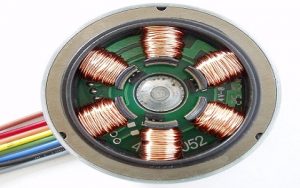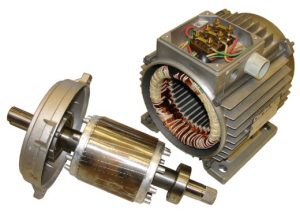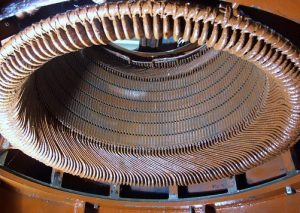At present, the development in motor performance has been increased, particularly with the enhancement of materials employed in motors. Additionally, improvement in performance is provided with the help of optimization techniques for the stator & rotor. The stator is an essential part of electrical machines that can be found in electric motors, generators, biological rotors, mud motors, and sirens. The flow of energy through a stator will be from the rotary part of the system. In a motor, the stator offers a rotary magnetic field to drive the rotary armature whereas, in a generator, it converts the rotary magnetic field to electric current. In liquid-powered devices, the stator directs the flow of liquid from the rotary element of the system.
What is Stator?
Definition: Stator is an immobile part of the electric motor, which includes several windings. Once an alternating current is applied to it, then its polarity will be changed all the time. When the power supply is given to the stator, an AC flows through the stator windings to create an electromagnetic field across the bars of the rotor. The alternating current (AC) makes the magnetic field rotate. This includes thin and stacked laminations, wounded by an insulated wire. The core in the stator includes a number of these laminations.

stator-in-motor
The motor’s stator housing is designed with aluminum up to 22 kW, whereas motors with high outputs contain cast-iron stator housings. Stators with different poles are most commonly used in connection with a pump to decide the force & the flow through the speed. The stator is mainly designed for handling different frequencies, voltages, outputs as well as an unstable no. of poles.
Construction of Stator
The construction of stator can be done with the laminations of high-status alloy steel so that eddy current losses will be reduced. The essential parts in the stator are the outer frame, core, and winding. The stator diagram is shown below.

stator-construction
1).Outer Frame
This is an external part of the motor. The main function of this frame is to provide support for the core as well as inside parts of the machine. For small motors, the external part is cast however for the huge machine. The construction of the stator is shown below.
2). Stator Core
The designing of this can be done with high position silicon steel stampings. The main function of this core is to hold the irregular magnetic field which generates losses like eddy current & hysteresis.
The stampings are connected to the frame in the stator, where each stamping is insulated with a slight varnish coating. Generally, the stamping thickness mainly changes from 0.3mm to 0.5 mm. The slots are connected in the inside of the stampings.
3). Stator Windings
The stator core holds 3-phase windings which get supply from a 3-phase supply system. Stator windings include six terminals where two of every phase is connected to the terminal box in the machine.

stator-windings
The stator in the motor is wounded for a specific number of poles, based on the motor’s speed. If the no. of poles is larger, then the motor speed will be decreased. Similarly, if the no. of poles is fewer, then the motor speed will be increased.
The relationship between the speed as well as the motor can be given like the following.
Ns ∝ 1/p (or) Ns = 120f/p
The connection of windings in the motor may be in start & delta.
Working Principle
In motors, the stator is a stationary part and the main function of this is to produce the rotary magnetic field due to three-phase supply. If the stator is in idle state, then the electromagnetic energy will be induced due to the electromagnetic induction phenomenon.
Stator in Motors
Stator mainly works based on a spinning electromotive device configuration like the field magnet or the armature. The field magnet is used to communicate with the armature to produce motion whereas the armature gets its influence from moving field coils on the rotor.
In the first DC motors and DC generators, field coils are placed on the stator. This is essential due to constantly moving power switch namely the commutator, and it is required to maintain the field properly aligned across the rotary rotor. When the current increases, the commutator becomes bigger as well as strong.
The stator in the motor may be an electromagnet otherwise a permanent magnet. As the stator is an electromagnet, then the coil strengthens which is known as the field winding & field coil.
The coil in the motor can be either an aluminum core or iron core. But the manufacturers always use copper wire in windings like the conducting material. Aluminum has less electrical conductivity, so it can be used as an alternate material within partial hp (horsepower motors), particularly for very small durations.
Stator in Turbine
The stator in the turbine includes ports or blades used for redirecting the flow of liquid. Such kind of devices contains the steam turbine as well as the torque converter. For instance, the stator in a mechanical siren includes one or several lines of holes that confess air into the rotor, so that the air can be controlled through the holes, and the siren sound can be changed. A stator gives great results to decrease the instability and rotating energy which is introduced through an axial turbine fan.
Thus, this is all about the stator, it is the fixed part of the machine. It uses a 3-phase supply to generate the rotating magnetic field. Therefore, an e.m.f can be induced due to the communication of the magnetic field between the stator and rotor. Here is a question for you, what are the uses of stator?